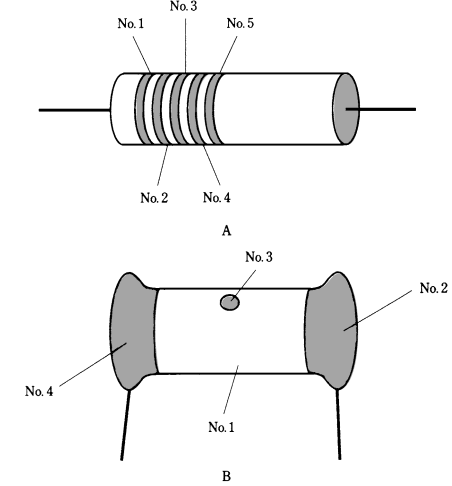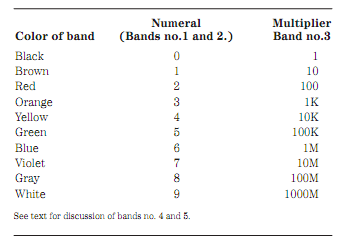Color code
Some resistors have color bands which indicate values and their tolerances. You will see 3, 4, or 5 bands around carbon-composition resistors and film resistors. Other units are large so that the values can be printed on them in the ordinary numerals. On resistors with axial leads, the bands (1st, 2nd, 3rd, 4thand 5th) are arranged as shown in the Figure given below. On resistors with radial leads, the bands are arranged

Figure-- At A, location of color code bands on a resistor with axial leads. At the point B, location of color codings on the resistor having radial leads.
As shown in the figure drawn above. The 1st 2 bands represent numbers 0 through 9; the 3rd band represents a multiplier of 10 to some power. For moment, do not worry about the 4th and 5th bands. Refer to Table given below.
Table: Resistor color code

Assume that you find a resistor whose 1st 3 bands are yellow, violet, and red, in that order. Then the resistance is 4,700 Ω or 4.7 KΩ. Read yellow 4, violet 7, red × 100.
As another instance, suppose you stick your hand in a bag and pull out a unit with bands of gray, blue, orange. Refer to Table given above and calculate blue 6, gray 8, orange × 1000. Thus, the value is 68,000 Ω = 68 KΩ.
After a few hundred real life experiences with this color code, you will have it memorized. If you are not going to use resistors which often, you can always keep a copy of Table which is given above handy and use it when you desire it.
The 4th band, if there is one, indicates tolerance. If it is silver, it means that the resistor is rated at plus or minus 10 percent. If it is gold, the resistor is rated at plus or minus 5 %. If there is no 4th band, the resistor is rated at plus or minus 20 %.
The 5th band, if there is one, indicates the percentage which the value might change in 1,000 hours of use. A brown band shows the maximum change of 1 % of the rated value. A red band indicates 0.1 %; an orange band indicates 0.01 %; a yellow band shows 0.001 %. If there is no 5th band, it means that resistor might deviate by more than 1 % of the rated value after 1,000 hours of use.
A good engineer always tests a resistor with the ohmmeter even before installing it. If the unit is labeled wrong somehow, it is easy to catch while assembling the complex electronic circuit. But once circuit is all together, and it will not work because some resistor is mislabeled.